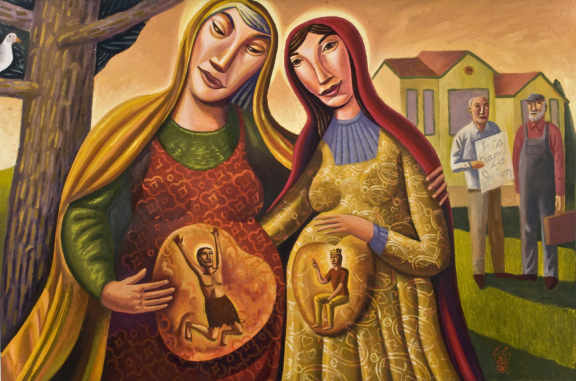The Visitation
Mount Calvary Church
Rev. Albert Scharbach, Pastor
A Roman Catholic Parish
The Personal Ordinariate of the Chair of S. Peter
Eutaw Street and Madison Avenue
Baltimore, Maryland
December 23, 2018
Advent IV
10 AM Sung Mass
____________________
Common
Merbecke
____________________
Organ Prelude
Organ Postlude
In dulce iubilo
___________________
Anthems
Sergei Rachmaninoff
Богородице Дево, радуйся,
благодатная Марие, Господь с тобою.
Благословена ты в женах,
и благословен плод чрева твоего,
яко Спаса родила еси душ наших.
Rejoice, O virgin mother of God,
Mary full of grace, the Lord is with thee:
blessed art thou among women,
and blessed is the fruit of thy womb,
for thou hast borne the Savior of our souls.
Academic Choir of Kharkiv Philharmonic
__________
Darren Schmidt
Alma Redemptoris Mater,
quae pervia coeli porta manes, et stella maris,
succurre cadenti,
surgere qui curat, populo:
tu quae genuisti, natura mirante,
tuum sanctum Genitorem:
Virgo prius ac posterius,
Gabrielis ab ore sumens illud Ave,
peccatorum miserere.
Loving mother of the Redeemer,
gate of heaven, star of the sea,
assist your people who have fallen
yet strive to rise again;
to the wonderment of nature
you bore your Creator,
yet remained a virgin after as before;
You who received Gabriel’s joyful greeting,
have pity on us poor sinners.
____________________
Hymns
O Come, O Come Emmanuel is a translation of the Latin hymn Veni veni Emmanuel, which in turn is based on the seven O Antiphons, which are sung in the monastic office at the Magnificat on the days preceding Christmas. These antiphons are of ancient origin, dating back to at least the ninth century. The hymn itself, though, is much more recent. Its first appeared in the 18th century. It is interesting to note that the initial words of the actual antiphons in reverse order form an acrostic: O Emmanuel, O Rex, O Oriens, O Clavis, O Radix (“virgula” in the hymn), O Adonai, O Sapientia. ERO CRAS can be loosely translated as “I will be there tomorrow”. That is a fitting message indeed since Christ’s birth falls on the following day.
__________
Creator of the stars of light is a translation by John Mason Neale (1818–1866) of the 9th century Creator alme siderum. The translation captures the essence of the original Latin. Contrasting “everlasting light” with the “stars of night” in the first stanza is a common theological theme of Latin hymns. Stanza two refers to the great New Testament hymn found in Philippians 2:10-11.
